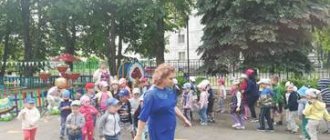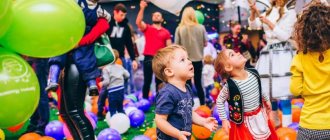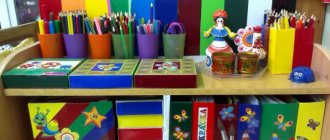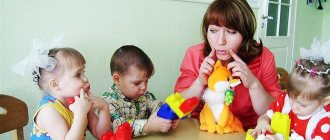Getting ready for the holiday
Children's matinees require careful preparation. Of course, the lion's share of the work falls on the shoulders of teachers. However, the comfort of the child’s stay at the event depends on the parents. There are no small details here.
First, make sure your child is an active participant in the activity. To do this, study the children's repertoire and repeat it at home. You should not miss rehearsals, participating only in the holiday itself. Your child will concentrate not on emotions, but on correct execution, and this will affect the quality and impressions.
Secondly, choose a costume that matches the overall theme of the holiday so that the clothing is appropriate. Choose a costume together with your child; it is important that the child likes the chosen outfit.
Thirdly, take care of the child's comfort. Clothes and shoes should be light, as the child will have to move a lot. At the same time, the baby should not be hot or cold, he should not experience discomfort associated with the details of the costume.
Fourth, think about your role at the holiday. Children are very pleased if their parents take an active part.
Basic rules for holding a New Year's party for children of different groups
Junior age category
- the morning time is chosen for the celebration,
- the matinee lasts 20-25 minutes, including time for presenting gifts,
- The holiday is accompanied by a teacher and an assistant.
You shouldn’t invite moms and dads to a celebration for kids 2-3 years old so that the children don’t get distracted. It’s better to make a video or video - parents will watch it later.
At this age, many children consciously see a large decorated Christmas tree for the first time, and some consciously meet Father Frost and the Snow Maiden for the first time. Therefore, Santa Claus can be replaced with familiar fairy tale characters if there is a risk that the elegant, impressive Santa will scare the children. The role of the Snow Maiden is usually played by one of the teachers. Her task is simple - take the kids to the Christmas tree, sing a song with them, show them toys, and organize a New Year's round dance.
Important! The program of the New Year's party for children aged 2-3 years always includes a surprise moment - the lighting of garlands on the Christmas tree.
Middle and senior groups
It is recommended to spend 34-45 minutes celebrating the New Year in these groups, including presenting gifts. The celebration can be held before lunch or in the afternoon. For children over 3 years old, the script is usually more complicated: it is based on a familiar fairy tale, but the number of characters increases and some of the roles are assigned to children.
The performance includes songs, poetry recitations, round dances and dialogue scenes in Russian and English. Relay races and games are selected from among active competitions, and roles are distributed so that each child can reveal his or her talent.
Important! By the age of 4-5, children are actively interested in cartoon characters and many strive to be like them. Take this into account when drawing up a scenario and creating a dress code for the holiday. It is advisable to choose the same gifts for children of each age group: universal, equally interesting for boys and girls. Also, the gift should not contain factory-made sweets and fruits.
At the New Year's party for older groups, it is necessary to constantly maintain interest in what is happening. Switching from one type of activity to another helps here, as well as including surprise moments in the script. In order not to tire the children, the program numbers are rehearsed separately from each other, and before the event there is one dress rehearsal.
I.A. Galkina (Ph.D.)
A holiday is a special state of mind, an emotional joyful upsurge caused by the experience of some special event. Holidays are of great importance for every person, but they are especially important for kids who look forward to them with great impatience and the most sincere joy. In preschool age, the foundations for all future development are laid. It is at this age that independent thinking is activated, children’s cognitive interest and curiosity develops. This is the most important stage in the development and education of the individual, the period of the child’s familiarization with the knowledge of the world around him and his entry into society. In this regard, the education of preschoolers’ artistic taste, the formation of their creative skills, and their awareness of the sense of beauty is of particular relevance. Children receive all this thanks to holidays, which are a real miracle for them, in which they themselves take a direct part. “Let everyone remember their childhood, and he will see that a holiday for a child is not at all the same as for us, that this is really an event in a child’s life and that a child counts his days from holiday to holiday. Childhood would be dull and gray if the Holidays were thrown out of it...” wrote K. D. Ushinsky.
Holidays and entertainment are bright and joyful events in the lives of preschool children. Combining various types of art, they have a great influence on the feelings and consciousness of children. Preparation and holding of holidays and entertainment serve the moral education of children; works of folklore, songs and poems about the Motherland, nature, and work form patriotic feelings; Participation in holidays and entertainment develops discipline and a culture of behavior in preschoolers. By learning songs, poems, and dances, children learn a lot of new things about the world and people. The festive atmosphere, the beauty of the room design, costumes, a well-chosen repertoire, the colorful performances of children - all these are important factors in aesthetic education. Aesthetic education is the most important component in the process of raising and developing a child. It contributes to the enrichment of sensory experience, the emotional sphere of the individual, affects the knowledge of the moral side of reality (it is known that for a preschooler the concepts of “beautiful” and “kind” are almost identical), increases cognitive activity, and even affects physical development.
The result of aesthetic education is aesthetic development. The participation of children in singing, games, round dances, and dancing strengthens and develops the child’s body, improves coordination of movements, develops the child’s body, improves coordination of movements. A holiday is also an excellent situation for activating speech and its communicative function. Thus, the holiday reveals the richest opportunities for the comprehensive development of the child. Holidays spiritually enrich a child, expand his knowledge about the world around him, help restore old and good traditions, unite children and adults, and encourage creativity.
When preparing holidays, adults should first of all focus on the interests of each specific child or group of children for whom this or that holiday is being prepared. And the main criterion for selecting material here is entertainment, brightness and fun. At the heart of every holiday and entertainment is a certain idea that should be conveyed to every child. This idea should run through the entire content of the holiday. Songs, poems, music, dances, dramatizations, and decoration serve to reveal the idea of the holiday. The idea of the holiday should be conveyed to each child, taking into account age and individual characteristics. In this case, a number of factors are taken into account: the children’s already existing repertoire, the level of development of their vocal and motor skills, and interests. Finally, speaking about the accessibility of the holiday, you should also remember about the time it is held. In children of primary and middle preschool age, fatigue occurs much earlier than in older preschoolers. Children from 2 to 4.5 - 5 years old are able to perceive a much smaller number of poems, songs, etc. Therefore, the duration of the holiday for them should not exceed 20-30 minutes. For older preschoolers, its duration increases to 45-55 minutes. and the repertoire becomes much richer and more diverse.
The holiday should be emotionally rich. The beauty of the setting, the solemnity of the music, the general high spirits - all this increases receptivity. Children want to actively participate in the holiday; they are not satisfied with the role of observers. And the adult is given the opportunity to satisfy the desires and need for activity of each child. You just need to choose the right form of manifestation for each. One will read poetry, another will sing, the third will dance.
The role of family holidays in a child’s life
In a person’s life, the personal and the public are closely intertwined. Holidays associated with the history of the country, with its traditions and rituals, allow a person to realize his unity with all the people. Through participation in festivities, a person becomes familiar with the spiritual culture of the people and feels involved in it. The world of kindness, beauty and harmony opens up to a person through the holidays. All holidays pass through the family and enter every home.
Family holidays contain rich potential for child development. A child needs a happy childhood; without it, a person will not be able to learn to fully love, and his emotional development as a whole will suffer. Without exaggeration, we can say that his personal life, his future family, and his activities will largely depend on the emotional state of the child’s holidays. All holidays, and children's holidays in particular, require not so much time and money as warmth and love.
Birthday
Among all family holidays, the most important for each family member should be Birthday. It is on this day that the attitude of the whole family towards the birthday boy is manifested. In turn, he has the opportunity to express his love and gratitude to each family member.
Birthday celebrations are prepared in advance, and if possible, everyone should take part in it. It is necessary to take into account the age characteristics of children: the younger the child, the brighter the holiday should be. This day is full of surprises and surprises. It’s good if there is an opportunity to capture this day, so that later a whole series of photographs of different ages can be formed. You should also try to save all the postcards you receive; then, using the texts of these congratulations, it is interesting to follow the changes in the child’s character and his hobbies. It is desirable that the congratulations be in verse, and also relate specifically to this person. It is better to compose poems yourself, even if they are not so perfect, they will be remembered better.
In families where a child grows up surrounded by brothers and sisters, there is a wonderful opportunity to use collective creative activities that unite children, teach mutual understanding and mutual respect. In collective work, everyone can show their abilities more clearly - write poetry, draw a newspaper, design a collage, make an appliqué and come up with much more.
The most exciting moment in the life of every birthday person is receiving gifts. Adults should think about giving a gift. The child will be pleased to see his gift immediately after waking up, next to his crib. In a family, not only close people, friends, but also favorite toys can congratulate a child on his birthday. For example, dolls can congratulate a girl, each doll can have her own gift. For a boy on his birthday, gifts can be brought on all his cars, where his new things can be on each one. Gifts can be waiting for a child everywhere: under a pillow, under a plate, in a basket of toys, on his bookshelf.
Handmade gifts or gifts with meaning are given in person. For memorable gifts, you can arrange a folder or shelf, and later pass this entire small archive to your children or grandchildren. The fact that in the family there is no division into “bad” and “good” gifts is also of educational importance. Everything that can be saved is stored.
Important elements of the holiday are decorating the room to create a festive mood. The birthday person can also take part in the decoration. From the chandelier to the cornice, you can stretch garlands on which the name of the hero of the occasion or “Congratulations” is written in separate letters. It’s nice to see a funny face on the mirror on your birthday, drawn with tinted toothpaste, and balloons above the ceiling. You can decorate the birthday boy’s armchair or chair by draping it with fabric.
You need to think through the menu in advance. This is also a great educational moment: children learn to behave correctly and gracefully, and most importantly freely, at an already set table. All dishes are decorated according to the age of the birthday person. It is better for children to serve individual well-decorated plates. Everyone is waiting for the birthday cake. The cake must be decorated with candles. This ritual, extinguishing candles and making a wish, is fascinating for everyone.
Various games are played during the celebration. You can hold a competition for the best compliment. Children also enjoy playing lotteries. Various small objects (threads, needles, pens, pencils, etc.) will be useful for this. In the wish lottery, wishes are written on separate pieces of paper, rolled up, and placed in a hat. Then everyone chooses a piece of paper. Comic wishes cause general merriment.
It’s interesting to play the game “What would that mean?” A photograph is glued to separate sheets of paper (maybe the birthday boy, or one of the guests), which depicts a funny, atypical situation. Each participant in the game signs and wraps it, passing it to another, thus preparing several photographs. All signatures are then read aloud, and the wittiest ones are awarded souvenirs. Surprises can be interesting wishes written on hearts; they are presented to the birthday person or all guests. Guests can receive birthday cake roses made from dough appropriate to the age of the birthday boy as a gift. Performing your favorite songs accompanied by a piano or karaoke will also bring great pleasure to everyone. You can also compose a song to a familiar melody, which reflects the life of the birthday person.
Celebrating family events
In the family, children participate in the celebration of their parents' birthdays. Parents are always pleased to receive gifts made by their child on their birthday: photo albums, postcards, drawings, applications, photo collages, etc.
Celebrating the parents' wedding day is a celebration of the family's birthday. The content of the holiday may include competitions dedicated to the “newlyweds” or interviews, when mom and dad openly answer various questions. Parents thereby maintain family ties and instill in their children a sense of responsibility and pride in their family. Getting to know your ancestry gives you a lot of new and useful things: the most important thing is that children develop a sense of belonging to the family and the Motherland as a whole. Thanks to the stories of grandparents, you can find out the ancestry of several generations and create a family tree of your family.
In general, any family event, even a small trip, can be turned into a holiday. For example, in the spring it is good to organize a trip to the forest to pick snowdrops. It is always a great joy to see the awakening of nature, the powerful force of green sprouts that reach for the sun. Meetings with nature are a trip to the world of beauty and harmony, and it is always a holiday. Not only a flower, but also any very beautiful place can be “imprinted” in memory. Many years later, when you remember this, a picture of this place and the memory of the holiday will appear before your eyes.
In our educational center , teachers and administration pay special attention to the aesthetic education of children and the organization of various holidays: “Farewell to Autumn”, “Welcome to Winter”, “New Year”, “Christmas”, “Farewell to Winter”, “Maslenitsa”, “Defender of the Fatherland Day” ", "Welcoming of Spring", "International Women's Day on the Eighth of March", "Easter", "Victory Day", "International Children's Day" and others. At the request of parents, it is possible to organize a festive congratulation of the child on his birthday in a peer group. Like the holidays, there are also open lessons before the New Year and at the end of the school year, where children not only show their parents what they have learned over the past time, but also play, participate in various contests and competitions, receive prizes, and such events, of course, , remain in the memory of children like holidays .
Who invented children's matinees? ⠀
So, who and why invented matinees in the first place?
Initially, of course, the idea was conceived as a holiday for the children. A significant event is coming: the Autumn Festival, New Year, March 8th. All these dates are a good reason to arrange a treat, as well as to show off your talents, who is capable of what.
Matinees began to be held in kindergartens in the USSR. The traditions of holding matinees go back to Soviet times. Each matinee was a real costume ball. The brightest were New Year's, February 23, “Dad's Day” and March 8, “Mom’s Day.”⠀
Modern matinees are in no way inferior to Soviet ones. Although it all depends on the specific kindergarten. Now the focus is on really showing the kids' abilities and what they have learned.
It is important for parents and teachers to see the fruits of their work. Note what each child is more inclined to do, what skills need to be developed. ⠀ At RigaKids, they carefully look and listen to the talents of their students!
What are children's parties?
Children's matinees are small holidays in which so many emotions, children's experiences, and the work of educators and teachers are invested.
Such holidays in kindergarten took place in the first half of the day, between breakfast and lunch. That's why they got that name.
The task of matinees is to diversify the lives of children, to make it brighter and more interesting. Matinees primarily have a general emotional meaning, but also perform a number of different pedagogical functions.
What functions?
How are children's matinees in kindergarten useful for children?
First of all, the task of matinees, as well as any holidays in general, is to add variety to the usual and monotonous way of life of children. Add positive emotions, colors and joy to it.
If we talk about the practical component of children's matinees, we can highlight several main pedagogical functions that they perform.
Which ones?
- motivation for creative activity. To perform at the matinee, children are taught to sing, dance, tell something, and so on. All this stimulates their creative development.
- Strengthens the relationship between parents and children. Parents most often also take an active part in preparing for the matinee, so their relationship is especially active during this period. They learn poetry together, choose an outfit for a performance, and so on.
- rally children. In addition to individual performances, children perform together at matinees. A common choir, rehearsals of skits, joint dancing, all this requires preparation and coordination. To do this, children need to learn to interact with each other.
Children's matinees are, as a rule, long-term joint work of children, their parents and teachers. During the preparation period and during the performance, many important tasks are solved.
Methodological recommendations for organizing a New Year's holiday
Natalia Rudak
Methodological recommendations for organizing a New Year's holiday
New Year is always a fairy tale and an encounter with a miracle. This holiday is loved and celebrated by everyone. without holidays
Holidays are of great importance in a child’s life: they give a powerful positive emotional charge, allow them to escape from problems and relax. The New Year's holiday is a special event, all children and adults look forward to it. The holiday brings a lot of positive emotions and is designed to solve a number of educational problems.
Recommendations and methodological advice for those who organize a New Year's party
First of all, you need to familiarize yourself with the holiday , develop a preparation plan, and make a list of necessary props. Select games, competitions, mass songs and dances that will be used at the holiday . Do not forget to record the phonograms on separate media, sign and number the order in which the phonograms are performed. There are also basic rules that it is advisable to adhere to during the New Year holidays :
• you should not try to reach the maximum number of children; it is better to hold 2 Christmas trees with fewer children than one with more;
• you should not install a Christmas tree in the center of the hall, since children should see what is happening, the Christmas tree should not interfere with this;
• do not hold matinees in an undecorated room, the design gives positive emotions, the design that matches the scenario will look advantageous;
• do not force children to sit still throughout the holiday , alternate types of activities;
• do not plan to introduce too many heroes holiday
• it is imperative to give children the opportunity to express themselves through competition and games;
• if poetry reading is planned, then sit the children on chairs and let this part of the holiday take place like a concert ;
• transitions from one action to another should be smooth.
Stages of work on the holiday
1. Pre-planning.
2. Work on the script.
3. Preliminary acquaintance of children with the theme of the matinee.
6. Holding a matinee.
7. Summing up.
Well- organized holidays have a beneficial effect on the development of mental processes: memory, attention, create an excellent situation for the development of a child’s speech, for consolidating knowledge acquired in various classes, and contribute to moral education.
Methodological recommendations for organizing physical education and recreational work with preschool children Goal: to improve the level of knowledge of teachers in organizing physical education and recreational work, to study program requirements for physical education.
Methodological recommendations for preschool teachers on organizing work with parents of pupils Methodological recommendations for teachers of preschool educational institutions on organizing work with parents of pupils Comfortable.
Methodological recommendations for organizing art competitions Organizing a competition requires careful planning and preparation. The culmination of each competition is the awarding of the winners.
Methodological recommendations for organizing OD (classes) taking into account the Federal State Educational Standard for Educational Education. Methodological recommendations for organizing OD (classes) taking into account the Federal State Educational Standard for Educational Education. Education (in the broad sense of the word: upbringing, training and development).
Methodological recommendations for organizing health strengthening activities in a preschool institution Physical education is part of universal human culture. It covers those aspects of life and education that are of utmost importance.
Methodological recommendations for organizing meals in a preschool institution Municipal budgetary preschool educational institution "Kindergarten "Solnyshko" town. Gvardeyskoye”, Simferopol district of the Republic.
Methodological recommendations for organizing role-playing games in a preschool educational institution. The importance of role-playing games in the development of a preschooler. Preschool childhood is the most important period of personality development. During these years, the child acquires.
Methodological recommendations for the creation and organization of the activities of a children's television studio. Methodological recommendations for the creation and organization of the activities of a children's television studio on the basis of an additional education institution. Chapter.
Methodological recommendations for organizing the work of creating mini-museums in preschool educational institutions Museum pedagogy is one of the areas of preschool pedagogy that is rapidly developing. It should be noted that in recent years it has appeared.
Analysis of types of holidays and entertainment in kindergarten
Olga Zhukova
Analysis of types of holidays and entertainment in kindergarten
In people's lives there is an alternation of everyday life and holidays , which are in many ways opposed to each other.
For children, the holiday has special meaning. K. D. Ushinsky notes that a holiday for a child is not at all the same as for an adult.
Holidays and entertainment are part of the cultural and leisure activities of the preschool educational institution. Through controlled cultural and leisure activities of children, it is possible to develop the child’s general culture, his creative individuality, to form the foundations of his positive attitude towards others, a positive “I-concept”
etc.
Classifying children's holidays on the basis of the generally accepted festive culture of Russia , M. B. Zatsepina and T. V. Antonova define the following types of children's holidays :
1) folk and folklore - Christmastide, Kolyada, Maslenitsa, Krasnaya Gorka, spring-summer games and fun, Autumn;
2) state and civil - New Year, Defender of the Fatherland Day, Victory Day, Knowledge Day, City Day, etc.;
3) international – Mother’s Day, Children’s Day, International Women’s Day;
4) Orthodox - Christmas, Annunciation, Palm Sunday, Easter, Trinity, Intercession;
5) household and family – birthday, school graduation;
6) "fantasy holidays "
–
Festival of Soap Bubbles , Festival of Balloons , Paper Boats, etc.
N.A. Vetlugina recommends celebrating the New Year on May 1, March 8 in the form of festive matinees , and on February 23, Victory Day, in the form of thematic complex classes.
As O.P. Radynova notes, the holiday performs important functions only if systematic work on the musical education of children is carried out in the kindergarten
Objectives of cultural and leisure activities in kindergarten A. N. Zimina sees the following:
- give children joy and encourage them to be active;
- give vivid artistic musical impressions;
- instill interest and love for music, develop musical sensitivity and musical activity of the child.
Organizing a children's party , as Yu. I. Bratchikova writes, includes the following preliminary work:
1) careful selection of script and actors;
2) selection of musical and literary material according to the theme of the holiday and the age characteristics of the children;
3) learning musical and speech material with children and teachers;
4) conducting rehearsals;
5) production of costumes and scenery;
6) selection of soundtracks, special light and sound effects;
7) preparing treats.
The content of children's parties is very diverse and is represented by: dancing, singing, artistic expression, dramatizations of poems and fairy tales, performances of small plays, jokes, reprises, and surprise moments.
The decoration of the holiday includes decorations , costumes and attributes for children, music. It is advisable that children participate in the preparation of holiday
Each type of holiday has its own customs and traditions.
Thus, the festive program of public holidays usually consists of three parts:
1) the first part, short in time (5 - 7 minutes, includes the ceremonial entrance of smartly dressed children with flags, flowers, branches, etc., formations, reading of poems, performance of 1 - 2 songs;
2) the second part is longer. It consists of collective and individual performances of children and spectacular moments. Children perform songs learned in music classes. A special place here is occupied by folk songs, games, round dances and dances familiar to children.
This part can take the form of a concert in which different types of activities alternate, or part of the repertoire can be united by one theme. This part includes dramatizations, games, and surprise moments.
3) in the final part, the children’s attention is again drawn to the main idea of the holiday . The presenter once again congratulates everyone present on the holiday ; the children can read in chorus a quatrain dedicated to the holiday . The children leave to the cheerful march.
The New Year's script traditionally consists of three parts:
1) first part - children examine the colorfully decorated Christmas tree, read poetry, and dance in circles;
2) the second part is the culminating one. Here Father Frost and Snow Maiden appear, who continue to lead the matinee, conduct attractions, games, ask riddles, etc.;
3) the third part is the final one. Father Frost and Snow Maiden say goodbye to the children. After one or two mass dances (round dances)
Around the Christmas tree, children disperse into groups.
Holidays dedicated to farewell to kindergarten and seeing off children to school are distinguished by a warm atmosphere of friendly attention.
Children of the preparatory group perform their favorite songs, games, dances, watch performances by children from other groups, accept congratulations, flowers, and souvenirs from them. kindergarten workers and promise to do well at school.
Holidays dedicated to children's birthdays are usually held as a kind of family celebration.
To a child (group of children)
a small concert is dedicated, gifts are given (homemade items, drawings made by peers. Birthdays are best held in the afternoon and end with tea with cake and sweets.
In recent years, it has become a tradition in many preschool educational institutions to hold joint parent-child holidays .
Such a holiday , as E.V. Ogorodova notes, can consist of four parts:
1) the first part is a theatrical performance in which children, parents, and teachers can show their skills;
2) the second part is a general tea party, for which the table is set in accordance with the theme of the holiday ;
3) the third part – games and competitions for children and adults. Games can be active and didactic in nature, with musical, intellectual, comic and other content;
4) fourth part – reflection (summarizing the results of the holiday )
.
Holidays school year include more games and shows, since children have not yet had time to master a more complex repertoire.
We emphasize: every holiday (matinee, entertainment )
must be based on a well-thought-out scenario and be carefully prepared.
The script reflects the main idea of the holiday and does not allow the progress of the holiday to “scatter”
.
The scenario must correspond to the age capabilities of the children. It is necessary to take into account the musical and other creative skills of children for a specific period.
When working on a script, as M. V. Parkhomenko points out, it is necessary to take into account the following principles: accessibility, content, entertaining, entertaining , educational, full of movement, dynamism, “surprise”
.
It is recommended to adhere to the following rules:
- interesting story;
- the game as the basis of the holiday , or a single gaming theme of the holiday ;
- alternating spectacular moments with active actions of children;
— building a program on musical and speech material previously mastered with children;
- inclusion of motor and general developmental exercises , outdoor games;
- age-appropriate duration of the holiday (from 20 minutes for young children to 45 minutes for older preschoolers).
Much attention should be paid to the selection of musical material for the holidays .
Teacher (music director, educator, methodologist)
thinks over the theme, form
of the holiday , selects musical and literary material. Numbers for children should be selected according to their strengths and inclinations; children should enjoy participating in the holiday .
The host of the holiday is artistic , with good speech culture. He must have the skills to communicate freely with children and adults, since he is the one who creates a positive and friendly mood at the matinee.
The musical director ensures the full sound of musical works and their artistic performance, if possible. It should be remembered that a variety of vivid impressions can cause inhibition in children or, on the contrary, excessive mobility. In all unforeseen cases, the host must show restraint and resourcefulness in order to return the holiday to the right direction .
A good tradition is “seeing off the holiday ”
. In the music hall, decorations, costumes and attributes are left for games and performances.
Entertainment is one of the types of cultural and leisure activities of preschool educational institutions.
Entertainment – colorful moments that develop creative activity and enrich children with impressions. In addition, children in entertainment can show independence, gain confidence in their abilities, develop communication skills, personal qualities, etc.
Entertainment is classified , depending on the activity of children, into three types. These are entertainments in which children:
1) only spectators and listeners;
2) participate independently;
3) participate together with adults.
When organizing entertainment of the first type, children are involved in decorating the group, hall, and making invitation cards and attributes. In entertainment , where children are only spectators and listeners, a positive emotional mood is transmitted to them in the process of perception.
In the second type of entertainment, children themselves prepare numbers for performances, stage plays, act out roles, and participate in various games. This type of entertainment helps the teacher find something to do for each child.
The second type of entertainment makes it possible to include children more widely in the process of preparation and performance. They themselves prepare numbers for performances, stage performances, act out roles, and take an active part in various games. This type of entertainment allows the teacher to find something to do for each child, which has a positive effect on the formation of the foundations of an individual’s culture.
Third, a mixed type of entertainment allows children to expand their communication with adults and peers. in this type of entertainment .
Entertainment can be classified according to its content :
1) theatrical (puppet, shadow, finger theater, etc.)
;
2) educational (quizzes, Club of cheerful and resourceful people, etc.)
;
3) sports (outdoor games, relay races, attractions, competitions)
;
4) musical and literary concerts;
5) jokes, tricks, riddles, surprise moments.
Let's take a closer look at the last type of entertainment .
Jokes can be used during breaks between games, at holiday parties and entertainment .
Tricks that have something mysterious associated with them always arouse keen interest in children.
Surprises are unexpected and fun moments that evoke many positive emotions in children.
After celebrations and entertainment, it is extremely important to consolidate the impressions and knowledge acquired by children. Impressions of the holiday and entertainment can be captured in drawings, modeling, stories and conversations. Children repeat their favorite dances, songs, and actions of individual characters.
Thus, holidays and entertainment are integrated , aesthetic and social phenomena, significant events in the life of a kindergarten . The task of preschool teachers is to make the children's holiday and entertainment unforgettable , to leave a bright mark on the souls of the pupils.






